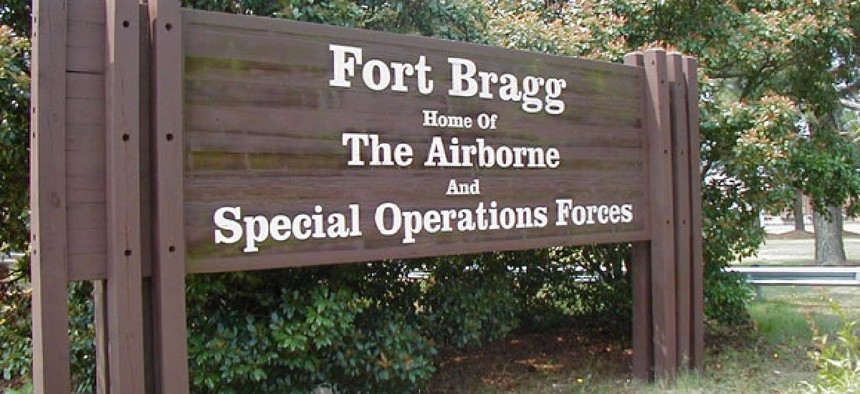
Fort Bragg is one of the stops on the listening tour. Wikipedia Commons
Analysis: Listening Tour Gauges Real Cost of Army Cuts
Comment sessions highlight impact of bases on surrounding communities.
As April comes to a close the Army is wrapping up listening sessions across the nation, where officials have heard from communities surrounding 29 installations about the impact the service has on their hometowns.
No, these sessions are not associated with the Base Closure and Realignment Commission. This Congress is no more likely than the last to approve new BRAC rounds. Nor are the sessions related to sequestration. The listening tour and the Army’s request for comments from localities earlier this year are tied to the service’s plan to cut the active-duty force from 540,000 to 490,000 by 2017 and eliminate at least eight brigade combat teams.
The Army already has begun reducing its civilian workforce of more than 200,000 employees.
“People realize that cuts in federal spending must happen,” said Douglas Peters, president and chief executive officer of the regional chamber of commerce in Fayetteville, N.C., after a session April 22 to discuss Fort Bragg’s future. As one of the 40 speakers at the forum, Peters said he came away feeling like it was “a very positive give and take” that highlighted for the record what the community does for the Army.
“We’ve been very supportive of our warfighters since the early 1900s,” he said. “We told [the Army] how we take care of the military families when the soldiers deploy.”
With its 44,000 service members and 11,000 civilians, Fort Bragg “is the economic engine” in Fayetteville, Peters said. “Forty percent of our economy is tied to Bragg,” he added. The installation pumps $10.9 billion into the local economy. It also has spurred the city’s population growth from 150,000 residents a decade ago to 210,000 now. After the 2005 BRAC round that closed Fort McPherson in Atlanta, the Army moved the Army Reserve Command and its several thousand civilian employees to Fort Bragg.
But growth has come at a cost, Peters said, citing the added demands on local schools and roads. “We’re the only major Army installation that was not connected to the interstate highway system.” Now the county is building a highway outer loop to move traffic more efficiently on and off post.
In West Texas, Richard Dayoub of the Greater El Paso Regional Chamber of Commerce has dealt with similar issues in his city, which is home to Fort Bliss. State and local officials developed a creative financing plan to build the 7.4-mile Liberty Expressway that connects the base to the airport. Dayoub notes this is one example of the Army working together with surrounding communities to address a host of problems.
But along with the challenges come opportunities.
The Army’s growth has been spectacular in the El Paso area, where most of the troop movement and spending took place during the 2005 BRAC round. Fort Bliss, formerly a post with about 9,400 soldiers, is now home to anywhere from 35,000 to 39,000 soldiers, with most in maneuver units. The result has been $5 billion in new construction for the surrounding community.
Another benefit is the new Texas Tech Health Sciences Center at El Paso, which works “hand-in-hand” with Fort Bliss’ William Beaumont Army Medical Center, Dayoub said. The school “is a pipeline for recruiting physicians and health professionals” into the Army, he said.
Fort Drum in Jefferson County, N.Y., presents a different scenario. “We’re very rural,” said Carl McLaughlin, executive director of the Fort Drum Regional Liaison Organization. In a region of dairy farms, the county’s population of about 120,000 is about half the size of Fayetteville. Fort Drum, the Army’s only active-duty installation in the Northeastern United States, hosts about 18,000 soldiers.
“We’ve added capacity in significant ways,” McLaughlin said about Jefferson County. He pointed to the recent Samaritan Hospital expansion as an example. “Fort Drum doesn’t have a hospital,” he said, adding that soldiers’ families account for 1,000 of the 1,700 births at Samaritan each year. The county also added 1,600 housing units to accommodate the addition of a brigade combat team in 2007, along with 1,600 hotel rooms to handle the 80,000 active-duty, Army National Guard and Army Reserve soldiers that train there annually.
This kind of investment by local government and businesses also can mean more debt for a region trying to make ends meet. With a 10 percent unemployment rate, McLaughlin said the county needs the Army’s active-duty population and civilian workforce of 4,400 to remain stable.
“We’re not crying or bleeding here,” he said. “We’re very good partners.”
In Fayetteville, on the other hand, a reduction in the Army’s active-duty force at Fort Bragg might not have much effect, according to Peters. If a brigade combat team of 3,500 soldiers were eliminated at Fort Bragg, it likely would be replaced by more Special Operations forces, which are projected to grow over the next five years, he said.
For now it is wait and see at the 29 installations. Army officials do not expect to make any restructuring announcements before the third quarter of fiscal 2013.
John Grady, retired director of communications for the Association of the United States Army, writes about defense and national security.







